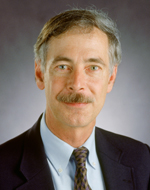Bio: Peter Asbeck joined the UCSD faculty in 1991. He received his Ph.D. from MIT in 1975. He worked at the Sarnoff Research Center in Princeton, NJ and Philips Laboratory in Briarcliff Manor, NY, before joining the Rockwell International Science Center (Thousand Oaks, CA) in 1978. While there, he carried out pioneering work in the area of heterojunction bipolar transistors, including development of high-speed devices and circuits based on III-V compounds and heterojunctions. He stayed there until joining UCSD in 1991. He currently leads the UCSD High-Speed Device Group, including work on HBT and HFET devices, Silicon on Sapphire (SOS) technologies, power amplifier architectures and characterization, and opto-electronic interface circuits. Asbeck is also on the Executive Committee of UCSD's Integrated Technologies Laboratory (ITL).
Research: With a dozen patents to his name, Professor Asbeck spent the first part of his career in industry. He is one of the pioneers in the area of HBTs (heterojunction bipolar transistors). Currently, the focus of his research is on developing technologies for more efficient microwave power amplifiers in wireless telephone handsets and base stations. The advanced transistors under development in his lab involve III-V materials including gallium arsenide, indium phosphide, and gallium nitride. Asbeck also works on high-speed wireline circuits and fiber-optic devices, and is researching smaller, more efficient wireless antennas to make way for communicators with multiple antennas to maximize access. Asbeck can talk about the future of the wireless industry from the perspective of someone who has helped make cell phones more efficient. He is an expert on the competing requirements of third-generation wireless standards (CDMA2000, W-CDMA) when it comes to amplifiers and transistors. Asbeck is also associated with the California Institute for Telecommunications and Information Technology and its plans to deploy wireless environmental sensors that will require much smaller and more efficient power amplifiers.
|

